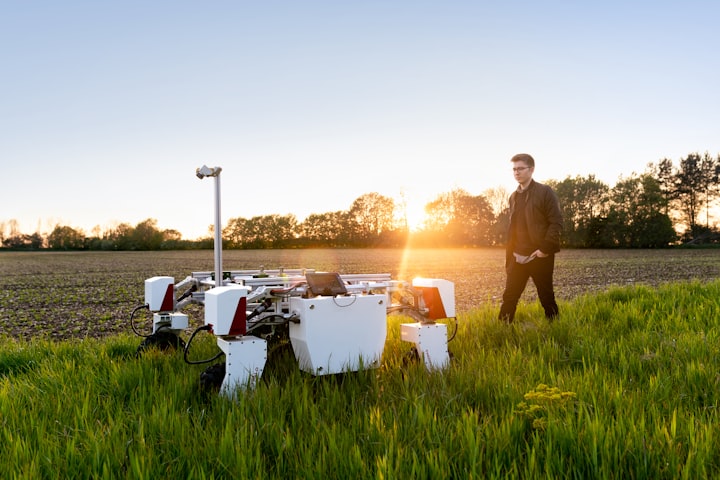
AI and Agriculture:
1.”Revolutionizing Agriculture with AI: How Machine Learning is Transforming Farming Practices"
2.”AI in Agriculture: The Future of Sustainable Food Production"
3.”How AI is Helping Farmers Improve Crop Yield and Quality"
4.”The Role of Robotics in Modern Agriculture: Enhancing Efficiency and Productivity with AI"
5.”From Seed to Shelf: How AI is Revolutionizing the Agriculture Supply Chain".
1.”Revolutionizing Agriculture with AI: How Machine Learning is Transforming Farming Practices"
Agriculture has always been an essential part of human civilization. As the global population grows, the demand for food is also increasing, making it imperative for the agricultural industry to adopt modern technologies to increase productivity, optimize resources, and improve sustainability. One such technology that is revolutionizing the agriculture sector is Artificial Intelligence (AI), particularly machine learning.
Machine learning is a subset of AI that allows computer systems to learn and improve from experience without being explicitly programmed. By analyzing large datasets and identifying patterns, machine learning algorithms can make predictions and recommendations that can help farmers make better decisions and improve farming practices.

One area where machine learning is transforming agriculture is precision farming. Precision farming involves using technology to monitor and analyze various factors like soil moisture, temperature, and nutrient levels, among others. With machine learning, farmers can predict the optimal time for planting, watering, and harvesting, among other activities, based on historical data and real-time inputs from sensors and weather forecasts. This not only helps to increase crop yield but also reduces the use of resources like water, fertilizers, and pesticides.
Another area where machine learning is making significant strides is in crop disease and pest detection. Traditional methods of detecting crop diseases and pests involve visual inspection, which can be time-consuming and inaccurate. Machine learning algorithms can analyze images of crops to identify diseases and pests, enabling farmers to take appropriate action before the problem spreads. This helps to reduce crop losses, increase yields, and minimize the use of pesticides.
Moreover, machine learning is also transforming the livestock industry. By analyzing data on animal behavior, health, and growth, machine learning algorithms can predict diseases and identify the best time for breeding and milking. This helps farmers to optimize livestock management, reduce the risk of diseases, and improve the quality of milk and meat.
In conclusion, machine learning is transforming the agriculture sector by providing farmers with valuable insights into crop growth, disease and pest management, and livestock management. By using machine learning algorithms to analyze large datasets, farmers can make informed decisions that improve productivity, sustainability, and profitability. As the technology continues to evolve, we can expect more significant advances in agriculture that will help us feed a growing global population while ensuring sustainable and efficient use of resources.
2.”AI in Agriculture: The Future of Sustainable Food Production"
As the world population continues to grow, there is an increasing need for sustainable food production practices that can keep up with the demand while minimizing environmental impact. One promising solution to this problem is the use of Artificial Intelligence (AI) in agriculture. AI-powered technologies are transforming the agriculture sector by providing farmers with valuable insights into crop growth, weather patterns, and soil health, among other things.
One of the key benefits of AI in agriculture is its ability to improve the efficiency of farming practices. By analyzing data from sensors, drones, and satellites, AI-powered systems can provide farmers with real-time insights into the condition of their crops and soil. This helps farmers to optimize their use of resources, including water, fertilizers, and pesticides, and reduce waste.

AI is also helping to make agriculture more sustainable by reducing the use of chemicals and other harmful inputs. With the help of machine learning algorithms, farmers can detect and respond to crop diseases and pests in a timely manner, reducing the need for pesticides. Furthermore, AI-powered sensors and weather forecasting tools can help farmers to make informed decisions about irrigation, reducing the amount of water used for farming.
Another way in which AI is revolutionizing agriculture is through precision farming. By analyzing data from various sources, including drones and satellites, AI can provide farmers with precise information on soil moisture, nutrient levels, and other factors that affect crop growth. This information can be used to optimize planting and harvesting times, reduce waste, and improve yields.
Moreover, AI can also help farmers to reduce their environmental impact by reducing greenhouse gas emissions. For example, AI-powered systems can optimize the use of machinery, reducing fuel consumption and emissions. Additionally, precision farming practices can reduce waste by ensuring that crops are harvested at the right time and under the right conditions, reducing the need for energy-intensive refrigeration and transportation.
In conclusion, AI is the future of sustainable food production. By providing farmers with valuable insights into crop growth, soil health, and weather patterns, AI-powered technologies are revolutionizing the way we grow our food. With the help of AI, we can create a more sustainable and efficient agriculture system that can meet the needs of a growing global population while protecting our planet's natural resources.
3.”How AI is Helping Farmers Improve Crop Yield and Quality"
One of the primary goals of modern agriculture is to produce high-quality crops with maximum yield. To achieve this goal, farmers need to take into account various factors that can affect crop growth, including soil quality, weather conditions, and pests and diseases. In recent years, Artificial Intelligence (AI) has emerged as a powerful tool for helping farmers to improve crop yield and quality.
AI is helping farmers to improve crop yield and quality by providing real-time data on soil health, moisture, and nutrient levels. With the help of sensors and other IoT devices, AI-powered systems can monitor soil conditions and provide farmers with insights into the best planting and harvesting times, as well as the optimal use of fertilizers and water. This helps farmers to maximize their crop yield while minimizing waste and reducing the environmental impact of farming practices.

AI is also helping farmers to identify and respond to crop diseases and pests in a timely manner. With the help of machine learning algorithms, farmers can analyze data on crop growth patterns and environmental conditions to identify early signs of disease or infestation. This allows them to take appropriate action before the problem spreads, reducing crop losses and improving the quality of their harvest.
Another way in which AI is helping farmers to improve crop yield and quality is through predictive analytics. By analyzing historical data on crop growth and weather patterns, AI-powered systems can provide farmers with predictions on future crop yields, allowing them to plan accordingly. This helps farmers to optimize their use of resources and reduce waste, while ensuring that they can meet the demand for high-quality crops.
Moreover, AI is also helping farmers to improve the quality of their crops. By analyzing data on soil quality, nutrient levels, and other factors, AI-powered systems can provide farmers with insights into the best ways to improve the taste, texture, and nutritional value of their crops. This can lead to higher prices and increased demand for their products, providing a boost to their bottom line.
In conclusion, AI is playing an increasingly important role in helping farmers to improve crop yield and quality. By providing real-time data on soil health, moisture, and nutrient levels, and by analyzing historical data on crop growth and weather patterns, AI-powered systems are enabling farmers to optimize their use of resources and improve the sustainability and efficiency of their farming practices. As the technology continues to evolve, we can expect even greater advances in agriculture that will help us meet the growing demand for high-quality crops while ensuring a sustainable and efficient food production system.
4.”The Role of Robotics in Modern Agriculture: Enhancing Efficiency and Productivity with AI"
The use of robotics in modern agriculture has the potential to revolutionize the way we grow our food. With the help of Artificial Intelligence (AI), robots can perform a range of tasks that were previously done manually, such as planting, harvesting, and weeding. This not only enhances efficiency and productivity, but it also reduces the need for human labor and improves the overall sustainability of farming practices.
One of the key benefits of robotics in agriculture is the ability to perform tasks with greater precision and accuracy than humans. With the help of sensors and other IoT devices, robots can analyze data on soil quality, moisture levels, and plant growth patterns to make informed decisions about planting, fertilizing, and harvesting. This results in higher yields and improved crop quality, as well as reduced waste and more efficient use of resources.

Another benefit of robotics in agriculture is the ability to operate 24/7. Unlike human laborers, robots can work around the clock without breaks or rest, allowing for more efficient use of time and resources. This can be especially beneficial during critical periods such as planting and harvesting, when time is of the essence.
Furthermore, robotics in agriculture can help to reduce the need for harmful chemicals and other inputs. By using robots to precisely apply fertilizers and pesticides, farmers can reduce waste and avoid overuse, resulting in a more sustainable and environmentally friendly approach to farming. Additionally, robots can be used to identify and remove weeds without the need for herbicides, further reducing the environmental impact of farming practices.
AI plays a crucial role in enhancing the capabilities of robotics in agriculture. With the help of machine learning algorithms, robots can learn and adapt to changing conditions, improving their accuracy and efficiency over time. For example, robots can learn to recognize different types of crops and adjust their planting or harvesting methods accordingly, resulting in higher yields and improved crop quality.
In conclusion, the role of robotics in modern agriculture is becoming increasingly important as we seek to improve the efficiency and sustainability of farming practices. With the help of AI, robots can perform a range of tasks with greater precision and accuracy than humans, resulting in higher yields, improved crop quality, and reduced waste. As the technology continues to evolve, we can expect even greater advances in agriculture that will help us meet the growing demand for high-quality crops while ensuring a sustainable and efficient food production system.
5.”From Seed to Shelf: How AI is Revolutionizing the Agriculture Supply Chain".
The agriculture supply chain is a complex system that involves numerous players, including farmers, distributors, processors, and retailers. From seed to shelf, every stage of the supply chain requires careful management to ensure that the right products reach the right customers at the right time. With the help of Artificial Intelligence (AI), the agriculture supply chain is being revolutionized, making it more efficient, sustainable, and profitable.

One of the ways in which AI is revolutionizing the agriculture supply chain is through predictive analytics. By analyzing data on weather patterns, crop yields, and market demand, AI-powered systems can provide farmers with predictions on the best times to plant and harvest their crops. This allows them to optimize their use of resources and reduce waste, while ensuring that they can meet the demand for high-quality products.
Moreover, AI can also help to streamline the distribution process by optimizing the routing and scheduling of trucks and other transport vehicles. By analyzing data on traffic patterns and delivery times, AI-powered systems can identify the most efficient routes for transport vehicles, reducing transportation costs and improving delivery times. This also helps to reduce carbon emissions and improve the sustainability of the supply chain.
AI is also helping to improve the efficiency of processing and packaging operations. By analyzing data on product quality and production rates, AI-powered systems can identify bottlenecks and inefficiencies in the processing and packaging process. This allows processors to optimize their operations, reducing waste and improving productivity.
Finally, AI is also playing a crucial role in improving the traceability and transparency of the agriculture supply chain. By using blockchain technology and other advanced systems, AI-powered systems can track products from the farm to the shelf, providing consumers with detailed information on the origin, quality, and sustainability of the products they buy. This improves consumer trust and confidence in the products, leading to increased demand and higher prices.
In conclusion, AI is revolutionizing the agriculture supply chain, making it more efficient, sustainable, and profitable. By providing farmers with predictive analytics, optimizing distribution routes, improving processing and packaging efficiency, and enhancing traceability and transparency, AI is transforming the way we produce, distribute, and consume food. As the technology continues to evolve, we can expect even greater advances in agriculture that will help us meet the growing demand for high-quality products while ensuring a sustainable and efficient food production system.
About the Creator
Bluepicks
Just some Indian Stuffs






Comments
There are no comments for this story
Be the first to respond and start the conversation.